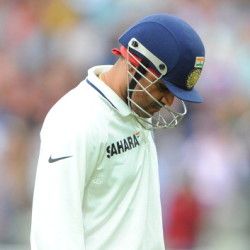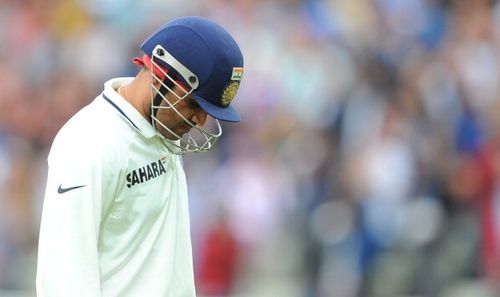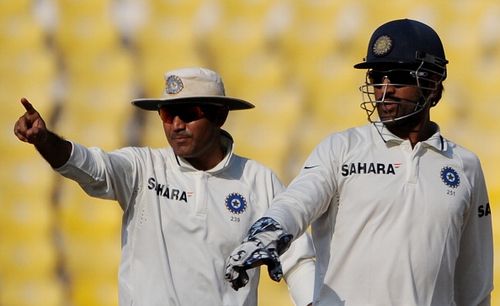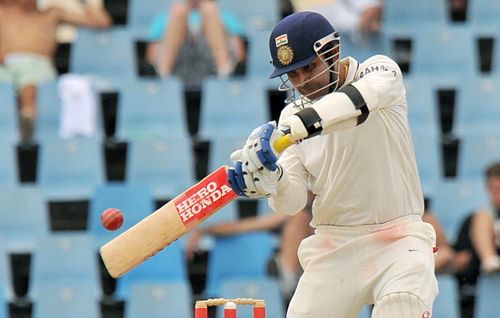
Virender Sehwag: The show isn't over, just yet!

25, 30, 9, 23, 49, 0, 2, 19 and 6 – after a swashbuckling 100 against England in Motera, that’s been Virender Sehwag’s contribution to the Indian scorecard and his waning cricket career. The cat has been belled. The selectors, finally, decided to bite the bullet and have cut loose one of the most entertaining batsmen in cricketing history.
However, the writing was on the wall. While the rest of the Indian batsmen made merry against a wafer-thin Australian bowling attack, the dashing opener drew blanks. His Delhi team mate, Gautam Gambhir, was shown the door ahead of the series, and now, by dropping Sehwag, the selectors have send a strong message – perform or perish. Last year, during the Asia Cup and the World Twenty20, Sehwag was repeatedly “rested” from the Indian side. But during the England ODI series there was no pretense. He was simply dropped. And now, again, the five stooges haven’t munched their words, and didn’t offer the respectable excuse of an “injury”.
But was it only his lack of form that cost Sehwag his place? It was a long time coming, because the Sehwag situation began to take shape way back in 2007, when the Men in Blue saw a radical shift in leadership. His struggle began when in a span of six months he went from being vice-captain to a batsman who was selected in the Test side for his spin bowling. His selection for the West Indies World Cup was based on past glories, and it didn’t sit well with the then coach, Greg Chappell. However, the whole Sehwag problem was pushed to the background, thanks to Greg Chappell again. The Aussie coach terrorized the team, displayed the wrong finger and cooked up a storm that blew away every other issue that needed attention.
However, the dust settled with Chappell calling it quits, and India in need of a new leader. Sehwag, one of Ganguly’s boys, was a front-runner for the job, but somebody “extremely” important suggested the name of an orange-maned cavalier from Ranchi. His ‘cool’ demeanor appealed to the big bosses, and he landed the job. Then it all changed. India won the inaugural ICC World Twenty20, and the Indian captaincy was never in doubt again. Anil Kumble walked into the sunset after a tough Aussie challenge and MS Dhoni usurped the hot seat of Indian cricket for all formats. Meanwhile, Sehwag found his way back, and was named as the second-in-charge. Thus began the era of the most “complicated” relationship in Indian cricket, between the captain MS Dhoni and his deputy Virender Sehwag.

Since then, MS Dhoni and Virender Sehwag have been like the two ends of a see-saw. Both have tried to keep it at a state of equilibrium, but it’s always difficult being friends with the guy who took what you wanted. And to be the second-in-charge, rubs it in that bit more. While in the world of commoners, this balance isn’t too tough to maintain; the problem arises when two superstars with flamboyance as their middle name get caught in a power struggle. The result – a rumoured cold uneasiness always lurking in the background. While India climbed atop the Test rankings and won the 2011 World Cup, this rift had a lid put on it, but after an 8-0 drubbing and a couple of sarcastic statements in Australia, the split cracked open.
But let’s brush aside the rift and focus on the main issue. Did Sehwag do enough to hold on to his place in the side? Did he merit selection on current form?
Sehwag has been below average with his performances, and his Test average has dropped below 50 for the first time in over three years. The team management, however, did offer him a longer rope because of the lack of quality alternatives. But Sehwag didn’t pay attention, deciding instead to flirt with danger. His 117 against England, in the first Test at Ahmedabad, seemed to have resurrected his career, but in his next six innings he collected a mere 136 runs.
However, it wasn’t only the string of bad scores that caused this exclusion. It was his approach to the game. His flaying ways of dominating the bowlers might be a treat to behold for the spectators, but his sense of responsibility has always been under the scanner. The most fascinating thing about Sehwag is that when he performs, he blows away all his failures with his extravagant show, but when the ball stops hitting the middle of the bat and the boundaries ebb, the edges look ugly and the gap between bat and pad, widens. The dropped catches at slip don’t help matters either. The swagger is misunderstood, and words like the technique, footwork, commitment, responsibility and now spectacles, start to surface.

While Greg Chappell described him being “happy to turn up and play and accept what came his way”, Duncan Fletcher, too, isn’t amused by his sulking approach to training. And when someone like Rahul Dravid expresses his concerns, it only strengthens the hands of the five wise men. The selection panel, under Sandeep Patil, has shown that it is ready to take tough decisions, and this move signifies a desire to move on to the future.
The axing from the Test squad has certainly brought Sehwag at the crossroads of his career. With the likes of Vijay, Dhawan and Rahane snapping at his heals; it will be a monumental task for the Delhi dasher to make a comeback. At 34, the reflexes aren’t getting any better and not everyone can do a “Ganguly”. But with Sehwag, there’s no script. He writes his the way he wants and when he wants. India still doesn’t have many players who can take on Dale Steyn, Morne Morkel and Vernon Philander on unfriendly tracks. So come November, don’t be surprised if you see a chubby man, batting in his 90s, lean back, open the face of his bat and uppercut a bouncer for a six over the slips to reach his hundred because…“That’s the way he plays!”